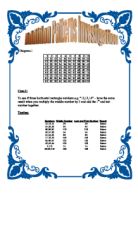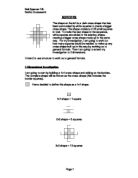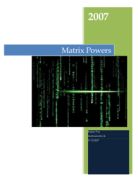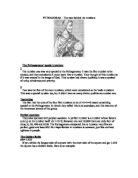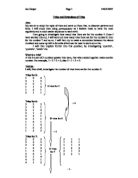To see if three horizontal rectangle numbers e.g. “12,13,14” – have the same result when you multiply the middle number by 2 and add the 1st and last number together.
Diagram.1 Case.1: To see if three horizontal rectangle numbers e.g. "12,13,14" - have the same result when you multiply the middle number by 2 and add the 1st and last number together. Testing: Conclusion: This happens because the mean of the 1st and last number is equal to the middle number i.e.: Mean of 12 and 14 = 13 Middle number = 13 The next part of the scenario was to multiply the middle number by 2 and plus the 1st and last number together; this is the same result - it can be proven when we write as it's shortest form i.e.: ( + ( = (2 ( ( 2= (2 Formula: Middle number multiplied by 2 = (First number) + (Last number) Case.2: To see if "Case.1" applies for horizontal and diagonal rectangles. Testing: Conclusion: The original formula (Case.1) also works for Variable.2. Case.3: Investigate what happens when Mary draws a rectangle around five numbers. Testing: I first tried to see if the formula for Case.1 applied for Case.3: Conclusion: The formula for Case.3 also works for rectangles with 5 squares whether it is diagonal, horizontal or vertical. Case.4 Investigate if the formula also works for any amount of rectangle squares: Testing: Conclusion: After doing the previous scenarios I have realised that by adding the first and last numbers together and then dividing by 2 makes the middle number (see formula in Case.4.) This works for any
Maths Coursework – N Lines
n Maths Coursework - N Lines Please note that this coursework depends heavily on the graphics available in the attached word document. RULES To find out the regions it is: Lines + lines + closed regions (n+n= closed regions) To find out crossovers it is: Lines ? (lines - 1) 2 n? (n-1) 2 To find out open regions it is: Lines ? 2 (n?2) To find out closed regions it is: Region - open regions 3 lines 1 2 3 4 5 6 7 7 regions 6 open regions closed region 3 crossovers 5 lines 1 2 3 4 5 6 7 8 9 10 11 12 13 16 regions 10 open region 15 6 closed regions 10 crossovers 14 16 6 lines 1 2 3 4 5 6 7 8 9 10 13 14 1 12 16 17 18 19 20 regions 15 crossovers 12 open regions 10 closed regions 20 21 22 This is what I predicted 7 lines 2 3 4 5 6 11 13 14 10 15 7 8 9
Borders - a 2 Dimensional Investigation.
BORDERS The shape on the left is a dark cross shape that has been surrounded by white squares to create a bigger cross shape. The shape consists of 25 small squares in total. To make the next shape in the sequence, white squares are added to the existing shape, creating a bigger cross shape made up in the same way. For my investigation, I am going to work out how many squares would be needed to make up any cross shape built up in this way by working out a general formula. Then I am going to extend my investigation to 3 dimensions. I intend to use structure to work out a general formula. 2 Dimensional Investigation I am going to start by building a 1x1 cross-shape and adding on the borders. The complete shape will be known as the cross-shape (this includes the border squares). I have decided to define this shape as a 1x1 shape. x1 shape = 1 square 2x2 shape = 5 squares 3x3 shape = 13 squares 4x4 shape = 25 squares 5x5 shape = 41 squares 6x6 shape = 61 squares I now have enough data to analyse my results: Number in sequence (n) Total number of squares (tn) 2 5 3 3 4 25 5 41 6 61 To work out which formula to use I will now put my results in a table showing the differences between the numbers: n tn 1st difference 2nd difference 1 4 2 5 4 8 3 13 4 12 4 25 4 16 5 41 4 20 6 61 I can clearly see that the 2nd difference is the
Portfolio: Continued Fractions
Continued fractions A continued fraction is a fraction whose numerator is an integer and whose denominator is an integer added to a fraction whose numerator is an integer and whose denominator is an integer added to a fraction, and so on. The continued fraction above is the first continued fraction to consider. But how do the ten first terms look like, and how does the relationship between them look like? Table 1. The ten first terms of the continued fraction above. n 2 3 4 5 6 7 8 9 0 tn tn 2.00 .50 .67 .60 .63 .62 .62 .62 .62 .62 The ten first terms of the sequence, which can be seen in Table 1, led me to the generalized formula for the sequence. However this sequence is not just a regular sequence, it is the Fibonacci sequence. And the Fibonacci sequence is a recursive sequence, which is a sequence in which a general term is defined as a fraction of one or more of the previous term. Graph 1. The value of the terms versus the term numbers. As n increases does the difference between the value of a term and the value of the term before decrease. This towards a specific value, and since we know that the sequence is the Fibonacci sequence we also know that the specific value the terms is moving towards is the golden ratio. When looking for the exact value of, for example, the 200th term problems arise. Mostly because of the fact that it is hard
Matrix Powers
Table of contents: Questions: .) Consider the Matrix M= Calculate Mn for n= 2, 3, 4, 5, 10, 20, 50. Describe in words any pattern you observe. Use this pattern to find a general expression for the matrix Mn in terms of n. 2.) Consider the matrices P= and S= P2= 2 = =; S2= 2 = = Calculate Pn and Sn for other values of n and describe any pattern you observe. 3.) Now consider matrices of the form steps 1 and 2 contain examples of these matrices for K=1 2 and 3. Consider other values of k, and describe any pattern(s) you observe. Generalize these results in terms of K and N 4.) Use technology to investigate what happens with further values of k and n. State the scope or limitations of k and n. 5.) Explain why your results holds true in general. SL type 1: Matrix Powers ) a) To calculate the value for matrix 'M' when n=2, the matrix must be multiplied by an exponent of 2. This would be shown and calculated as, x Therefore the value of matrix M2 = b) To calculate the value for matrix 'M' when n=3, the matrix must be multiplied by an exponent of 3. Therefore the value of M3 = c) To calculate the value for matrix 'M' when n= 4, the matrix x must be multiplied by an exponent of 4. Therefore the value of M4= d) To calculate the value for matrix 'M' when n=5, the matrix must be multiplied by an exponent of 5. Therefore the value of M5= e) To calculate the
Investigate calendars, and look for any patterns.
Maths Coursework Introduction: I was given a task to investigate calendars, and look for any patterns. I noticed several patterns, the first of which was the relationship between the starting days of different months, also I noticed the relationship between numbers in columns of the calendar, the relationship between numbers in the rows, Studying diagonal relationships, and Studying relationships between adjacent numbers. . Days on which months start First, I explore the days on which different months start. Which months are the same/ have a pattern? Ex 1.1 Study Sample Calendar: Month Starting day Friday 2 Monday 3 Monday 4 Thursday 5 Saturday 6 Tuesday 7 Thursday 8 Sunday 9 Wednesday 0 Friday 1 Monday 2 Wednesday From the above table, I can see that some of the months start on the same day, which means there may be a pattern when compared with other years. If so, then that means there is a pattern of which months start on the same day each year. The results of this first test are as follows: , 10 = same 2, 3, 11 = same 4, 7 = same 5 6 8 9, 12 = same Now I must investigate to find out if the pattern is the same in other years. In order to do this, I check a calendar of the year 2004. Ex 1.2: Results for 2004 Months ( n ) Start day Thursday 2 Sunday 3 Monday 4 Thursday 5 Saturday 6 Tuesday 7 Thursday 8 Sunday 9
I am to conduct an investigation involving a number grid.
Maths Coursework Part 1 Introduction I am to conduct an investigation involving a number grid. The first part of the investigation will involve me: ü Drawing a box around various random numbers on a number grid i.e. 2 x 2 numbers, 3 x 3 numbers, 4 x 4 numbers. ü I will then find the product of the top left number and the bottom right number in the boxes by multiplying them. ü I will then do the same with the top right and bottom left numbers. ü I am then going to calculate the difference between these products 10x10 Grid ü 2x2 Boxes Box 1 52 53 X X+1 62 63 X+10 X+11 [image001.gif] [image002.gif] 52 x 63 = 3276 x (x + 11) x2 + 11x [image003.gif] 62 x 53 = 3286 (x + 1) (x + 10) x2 + 11x + 10 = (x2 + 11x + 10) - (x2 + 11x) = 10 3286 - 3276 = 10 The difference between the two numbers is 10 Box 2 81 82 91 92 [image004.gif] 81 x 92 = 7452 91 x 82 = 7462 7462 - 7452 = 10 The difference between the two numbers is 10 Box 3 69 70 79 80 [image005.gif] 69 x 80 = 5520 79 x 70 = 5530 5530 - 5520 = 10 The difference between the two numbers is 10 ü 3x3 Boxes Box 1 8 9 10 X X+1 X+2 18 19 20 X+10 X+11 X+12 28 29 30 X+20 X+21 X+22 [image006.gif] [image007.gif] 8 x 30 = 240 x (x + 22) x2 +
Pythagoras - The man behind numbers
PYTHAGORAS - The man behind the numbers The Pythagoreans' special numbers The number one was very special to the Pythagoreans. It was the first number to be created, and they considered it much more than a number. They thought of this number as if it was created in the image of God. This number had divine qualities; it was a symbol of unity, wholeness and priority. 2 Two was the first of the even numbers, which were considered as the 'male numbers'. This was a special number too, but it didn't have as many divine qualities as number one. Teatraktos The fact that the sum of the four first numbers is ten (1+2+3+4) meant something special to the Pythagoreans. In Greek they called this sum teatraktos, and this was one of the innermost secrets of the group. Perfect numbers They also operated with perfect numbers. A perfect number is a number whose factors sum up to the number itself. (6: 1+2+3) Between one and 10,000 there are only four of these; 6, 28, 496 and 8128. The Pythagoreans compared this to humans: very few are perfect, good and beautiful. But imperfection in numbers is common, just like evil and ugliness in people. The Golden Ratio a/b= 1.618 If you divide the longest side of a square with the short side of the square and get 1.618 the square has a Golden Ratio. Here is an example: If you divide 3.2 cm with 2.0 cm you get 1.618. Therefore the square is
Study the topic of trios and work on from that, to discover patterns and links.
Trios and Extensions of Trios Aim: My aim is to study the topic of trios and work on from that, to discover patterns and links. I will study trios using permutations as I believe these to have the most regularity and a much easier sequence to work with. I am going to investigate how many trios there are for the number 5. Once I have worked this out, I will work out how many trios there are for the number 6; then for the number 7 and so on. I will then try to make a connection between the above numbers and come up with a formula which can be used to work out a trio. I will then explore further into this question, by investigating 'quartets', 'quintets', 'sextet' etc. What is a trio? A trio is a set of 3 numbers greater than zero, that when added together make another number. For example, 1 + 2 + 2 = 5, also 2 + 1 + 2 = 5. TRIOS: I will, first of all, investigate the number of trios there are for the number 5: Trios for 5: 2 2 2 1 2 2 2 1 1 3 3 1 3 1 1 Trios for 6: 2 2 2 3 2 1 3 1 2 2 1 3 2 3 1 4 1 1 4 1 1 4 2 3 3 2 Trios for 7: 3 2 2 5 1 1 2 3 2 1 5 1 2 2 3 1 1 5 2 4 1 3 3 4 2 3 1 3 2 4 1 3 3 1 2 1 4 4 2 1 4 1 2 Trios for 8: 2 5 5 2 2 5 1 2 1 5 5 1 2 5 2 1 3 4 4 3 3 4 1 3 1 4 4 3 1 4 1 3 6 1 1 6 1 1 6 2 2 4 2 4 2 4 2 4 2 3 3 3 2 3 3 3 2 Numbers of trios: 5 --> 6 6 --> 10 7 --> 15 8 --> 21 I
Consecutive Sums
Consecutive Sums Someone tells you that it is possible to make any number by writing an addition sum using only consecutive numbers. EXAMPLE 18 = 3 + 4 + 5 + 6 6 = 1 + 2 + 3 21 = 1 + 2 + 3 + 4 + 5 + 6 A) Is this person right? B) Can you make every number? C) Investigate and write down everything that you notice, as you go along. (E.g. patterns) ____________________________________________ A) This person must be wrong as they said you could make "any number" and I cannot make 8,16,32,40,56,64,80,88,96 this is not any number I feel this is sufficient proof to say that you can not make 'any' number. B) You can not make every number as a lot of numbers in the eight times table can not be made such as 8,16,32,40,56,64,80,88,96 so not every number can be made. C) CON NUMBERS 2 CON NUMBERS 3 CON NUMBERS 4 CON NUMBERS 5 CON NUMBERS 0 + 1 2 3 +2 0+1+2 4 5 2+3 6 +2+3 0+1+2+3 7 3+4 8 ** ** ** ** ** 9 4+5 2+3+4 0 +2+3+4 1 5+6 0+1+2+3+4+5 2 3+4+5 3 6+7 4 2+3+4+5 5 7+8 4+5+6 +2+3+4+5 6 ** ** ** ** ** 7 8+9 8 5+6+7 3+4+5+6 9 9+10 20 2+3+4+5+6 21 0+11 6+7+8 22 4+5+6+7 23 1+12 24 7+8+9 25 2+13 3+4+5+6+7 26 5+6+7+8 27 3+14 8+9+10 28 ** ** ** ** ** 29 4+15 30 9+10+11 6+7+8+9 4+5+6+7+8 I have noticed there is an equal gap each time. The more consecutive numbers the bigger the gap between


